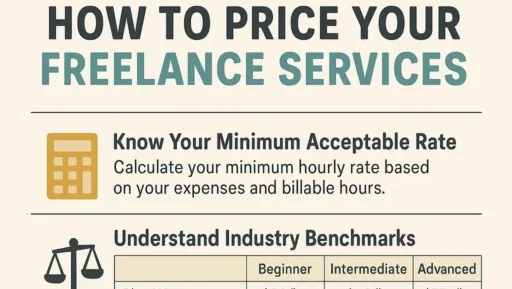For nearly every freelancer, one question causes more stress and self-doubt than any other: “What should I charge?” It’s a high-stakes balancing act. Price too low, and you’re on a fast track to burnout, feeling overworked and undervalued. Price too high, and you’re haunted by the fear that clients will simply pass you by. Finding that “sweet spot” feels less like a business decision and more like a guessing game.
But it doesn’t have to be. Confidently pricing your freelance services is a skill you can learn. It’s about shifting your mindset from what you think you can get to what your value truly is. This guide will provide a clear, step-by-step framework to help you calculate your rates, communicate your worth, and attract the right clients who are happy to pay for your expertise.
Why Your Pricing Strategy is Everything
Your rates are more than just numbers on an invoice; they are a powerful signal to the market. Your pricing strategy directly shapes:
- Client Perception: Professional pricing signals quality and expertise. Low rates often attract low-quality “bargain-hunter” clients who can be demanding and disrespectful.
- Your Business’s Health: Your rates determine your cash flow, your ability to invest in better tools and skills, and your overall financial stability.
- Your Confidence and Positioning: Charging what you’re worth is a powerful act of self-respect that boosts your confidence and positions you as a serious professional.
Step 1: Calculate Your Foundation—The Minimum Acceptable Rate (MAR)
Before you even think about the market, you must know your numbers. Your MAR is your non-negotiable floor—the absolute minimum you need to earn per hour to run your business and live your life. Working for less than this means you are effectively paying to work.
Here’s how to calculate it:
- List Your Monthly Personal Expenses: Rent/mortgage, food, utilities, transportation, health insurance, etc.
- List Your Monthly Business Expenses: Software subscriptions (Adobe, etc.), web hosting, marketing costs, accounting fees, etc.
- Add a Buffer for Taxes and Savings: In Brazil, as a freelancer (autônomo), you are responsible for INSS and Imposto de Renda. A safe bet is to add 30% of your total expenses to cover taxes and at least 10-20% for savings/profit.
- Estimate Your Monthly Billable Hours: This is NOT 40 hours a week. A realistic number for a full-time freelancer is often between 80-100 hours per month, after accounting for admin, marketing, and client communication.
Example Calculation (in BRL):
- Personal Expenses: R$ 4.000
- Business Expenses: R$ 500
- Subtotal: R$ 4.500
- Add 30% for Taxes: + R$ 1.350
- Add 20% for Savings: + R$ 900
- Total Monthly Need: R$ 6.750
Now, divide by your billable hours:
R$ 6.750 / 100 billable hours = R$ 67,50 per hour.
This is your MAR. You should not accept work that pays less than this. This number is your data-driven anchor of confidence.
Step 2: Choose the Right Pricing Model
Once you know your floor, you can decide how to package your services.
- Hourly Rate: Simple and transparent. Best for ongoing work, consulting, or projects with an undefined scope. The major drawback is that it penalizes you for being efficient.
- Project-Based Pricing: You charge a flat fee for the entire project. This is the most popular model as clients love the predictability. It rewards you for efficiency and allows you to price based on the value of the outcome, not just your time. This is the recommended model for most freelancers.
- Retainer Agreements: A client pays a fixed fee each month for a set amount of work or access to your expertise. This is excellent for creating predictable, recurring revenue.
- Value-Based Pricing (Advanced): Instead of your time or the project, you price based on the value you create for the client’s business. If your sales funnel design can generate an extra R$ 100.000 for a client, charging R$ 10.000 is a no-brainer for them. This requires deep confidence and a proven track record.
Step 3: Price for Value, Not Just Your Time
Clients don’t buy hours; they buy outcomes. They are paying you to solve a problem or help them achieve a goal. Your pricing should reflect that value.
- Shift your language:
- Instead of: “I charge R$ 80/hour for graphic design.”
- Try: “My Brand Identity Package, which provides you with a professional logo and visual guidelines to attract your ideal customers, is an investment of R$ 3.000.”
- Focus on the ROI: How will your work make or save the client money? Will it increase their sales, improve their brand reputation, or save them valuable time? Quantify this whenever possible.
Step 4: Simplify Your Sales with Tiered Packages
Don’t just give clients a single price. Offer them choices. Creating 2-3 tiered packages is a powerful psychological strategy.
- Example for a Social Media Manager:
- Basic (R$ 950/mês): 8 posts/month on one platform.
- Standard (R$ 1.800/mês): 12 posts/month on two platforms + monthly report. (This is usually the one you want them to pick).
- Premium (R$ 3.200/mês): 20 posts/month on three platforms + ads management + bi-weekly strategy call.
Packages guide the client’s decision, anchor your value, and make it easy for them to say “yes” to the option that best fits their needs and budget.
Step 5: Handle Pricing Objections with Grace and Strength
When a client says, “That’s too expensive,” do not apologize or immediately offer a discount. A discount devalues your work. Instead, stay calm and professional.
- Use this script: “I understand that this may be more than you budgeted for. The price I’ve quoted reflects the full scope of work and the value it will bring. If we need to work within your budget of [their budget], I’d be happy to explore which parts of the project we could simplify or remove to meet that number.”
This response is confident and helpful. It reframes the conversation from your price to their scope. A serious client will be willing to have this discussion. A bargain-hunter will walk away—and you’ve just saved yourself a future headache.
Step 6: Raise Your Prices Annually
As your skills, portfolio, and confidence grow, so should your rates. Review your pricing at least once a year. When you’re consistently booked out, it’s a clear sign that your prices are too low. Inform existing clients of the change well in advance, thank them for their partnership, and explain that the new rate reflects your increased expertise and the greater value you now provide.
Final Thoughts: Own Your Value
Freelance pricing is a skill that blends mathematics, market research, and self-worth. Stop guessing and start calculating. Use your MAR as your anchor of confidence, package your services professionally, and learn to communicate your value effectively. The right clients—the ones you want to work with—will respect your professionalism and be happy to pay for quality results. Charge what you’re worth. Your business depends on it.

